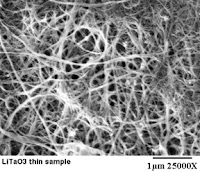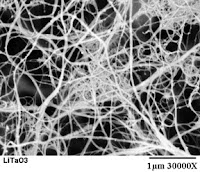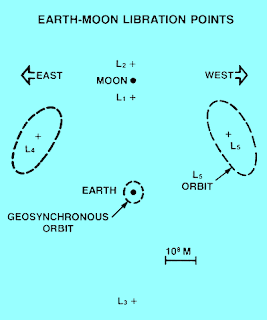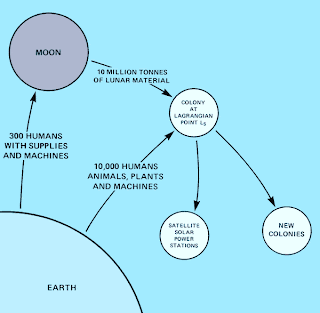Space Elevator Journal Update
0 views
Skip to first unread message
Space Elevator Journal
Dec 23, 2006, 7:04:50 AM12/23/06
to spac...@googlegroups.com
Space Elevator Journal Update
-
NIST Laser-Based Method Cleans Up Grubby Nanotubes
Posted: 22 Dec 2006 03:20 PM CST
Before
After
Before and after electron microscope images of a pyroelectric detector coated with single-walled nanotubes (SWNTs) visually demonstrate the effect of the laser cleaning process. In addition, the SWNTs look visibly blacker after laser treatment, suggesting less graphitic material and increased porosity. (Image and Caption Source: NIST)Before carbon nanotubes can fulfill their promise as ultrastrong fibers, electrical wires in molecular devices, or hydrogen storage components for fuel cells, better methods are needed for purifying raw nanotube materials. Researchers at the National Institute of Standards and Technology (NIST) and the National Renewable Energy Laboratory (NREL, Golden, Colo.), have taken a step toward this goal by demonstrating a simple method of cleaning nanotubes by zapping them with carefully calibrated laser pulses.
“Controlling and determining tube type is sort of the holy grail right now with carbon nanotubes. Purity is a key variable,” says NIST physicist John Lehman, who leads the research. “Over the last 15 years there’s been lots of promise, but when you buy some material you realize that a good percentage of it is not quite what you hoped.
"Anyone who thinks they’re going into business with nanotubes will realize that purification is an important—and expensive—step. There is a lot of work to be done.”
When carbon nanotubes—the cylindrical form of the fullerene family—are synthesized by any of several processes, a significant amount of contaminants such as soot, graphite and other impurities also is formed. Purifying the product is an important issue for commercial application of nanotubes. In a forthcoming issue of Chemical Physics Letters*, the NIST/NREL team describes how pulses from an excimer laser greatly reduce the amount of carbon impurities in a sample of bulk carbon single-walled nanotubes, without destroying tubes. Both visual examination and quantitative measurements of material structure and composition verify that the resulting sample is “cleaner.” The exact cleaning process may need to be slightly modified depending on how the nanotubes are made, the authors note. But the general approach is simpler and less costly than conventional “wet chemistry” processes, which can damage the tubes and also require removal of solvents afterwards. -
Space Weather Now at the Space Environment Center
Posted: 22 Dec 2006 03:18 PM CST
Freelance journalists spend a lot time with their noses in their browsers building their space elevator blogs. I use Firefox (this site is optimised for Firefox which you may already know if you use IE) and I love Accuweather's ForecastFox extension which puts 3 days and nights of weather in my browser's status bar.
This would be really useful if I ever actually got up from the computer and went ouside but for now it at least serves to remind me there IS an outside.A significant geomagnetic storm impacted the Earth beginning early Thursday afternoon around 1:00 p.m. Eastern time, 14 December, according to forecasters at the NOAA Space Environment Center in Boulder, Colo. Impacts from this event can cause problems with High Frequency communications, satellite operations and induce currents in power grids. (Source: ESA)Knowing Earth weather wouldn't be quite so useful if I lived and/or worked in space though. Knowing the space weather forecast can mean the difference between hidely safely behind radiation shielding or becoming a tiny, glowing constellation affectionately known as the Crispy Critter.
Space Weather Now ... give[s] the non-technical user a 'plain language' look at space weather. The page refreshes automatically once a minute.
The various sections are:
Events and Announcements
Solar X-ray Imager (SXI) - a Solar X-ray Imagers (carried by the Geostationary Operational Environmental Satellites (GOES) 12 and 13 spacecraft) that monitor the Sun’s X-rays for solar flares, coronal mass ejections, and other phenomena that impact the geospace environment .
National Oceanic and Atmospheric Administration (NOAA) Scales - The scales describe the environmental disturbances for three event types: geomagnetic storms, solar radiation storms, and radio blackouts. The scales have numbered levels, analogous to hurricanes, tornadoes, and earthquakes that convey severity. They list possible effects at each level. They also show how often such events happen, and give a measure of the intensity of the physical causes.
Maximum in past 24-hours - These are the highest values over the last 24-hours for Geomagnetic Storms; planetary K-values for the last 8 3-hourly periods. Solar Radiation Storms; average 5-minute protons at >10 MeV from primary GOES satellite. Radio Blackouts; X-ray 1-minute values from primary GOES satellite.
Currently - Geomagnetic Storms (latest 3-hour K-value), Solar Radiation Storms (averaged 5-minute proton value), and Radio Blackouts (x-ray 1-minute value) current values.
Real-time Solar Wind pages - Solar wind values collected by the Advanced Composition Explorer (ACE). Data is averaged over the last 15-minutes for the values. The latest dial display can be linked to at : http://www.sec.noaa.gov/SWN/sw_dials.gif. Explanation
Auroral Map - The plots on this page show the current extent and position of the auroral oval at each pole, extrapolated from measurements taken during the most recent polar pass of the NOAA POES satellite.
Today’s Space Weather - A look at space weather for the more technical user. This page has the latest full-disk image, the 3-day Solar-Geophysical Forecast, Solar X-ray Flux plot, Satellite Environment Plot, and more information.
D-region Absorption - Long range communications using high frequency (HF) radio waves (3-30 MHz) depend on reflection of the signals in the ionosphere.
Solar Image References - Link to additional descriptions and sources of solar images
Latest Alert - Updated hourly and as Alerts, Warnings, or Watches are issued.
Last Advisory Bulletin - Updated as a Space Weather Bulletin is issued. The file contains back bulletins for the last 8 months.
Solar Cycle 23 Progression - A plot indicating the progression of the current solar cycle. These are updated at the first of each month.
Today’s Theme - A variety of short subject themes about space weather, products, services, or projects. They change each day and rotate through the provided list of themes.
USER Groups - Links to specific pages of importance to the various user categories served by SEC.
--PB--
Email Delivery powered by FeedBurner
You are subscribed to email updates from Space Elevator Journal
To stop receiving these emails, you may unsubscribe now.
If you prefer to unsubscribe via postal mail, write to: Space Elevator Journal, c/o FeedBurner, 549 W Randolph, Chicago IL USA 60661
Space Elevator Journal
Dec 27, 2006, 7:04:14 AM12/27/06
to spac...@googlegroups.com
Space Elevator Journal Update
-
The Astronaut Farmer - Private Space Flight Goes Hollywood
Posted: 26 Dec 2006 03:26 PM CST
You have to know somebody who would start a space elevator blog is not-exactly pro-rocketry. Besides the tons of pollutants thrown with every launch and the space debris blanketing the earth from decades of throw-away booster stages, dead satellites etc., rockets just strike me as horribly inefficient and needlessly expensive. Not that the space elevator will be cheap to build but, once built, the cost of getting to space decreases with each lift.
All that aside for the moment, what caught my eye is not the fact that someone wrote the story but that it got financed. Hollywood thinks there's a market for space-related movies.
The Astronaut Farmer is about a NASA astronaut (played by Billy Bob Thornton) who is forced to retire to save his family farm. Unable to give up his dream of space travel, he builds his own rocket despite the government's threats to stop him. (View Trailer)
This seems like another All-American-boy-with-a-dream movie and space travel just happens to be far out enough to make the protagonist seem crazy but realistic enough to actually happen while being something the movie-going public can grasp. So the Hollywood money is mostly behind the moral carried in the tagline: If we don't have our dreams, we have nothing. Still, I'm glad to see private space travel is somewhere in our collective psyche.
Space Elevator Journal
Dec 28, 2006, 7:04:42 AM12/28/06
to spac...@googlegroups.com
Space Elevator Journal Update
-
Exploring Earth from Space for Free
Posted: 27 Dec 2006 10:43 AM CST
The beautiful images of Earth returned from space always fill me with awe and wonder. When the space elevator is up and running, first-hand experience of the 'astronaut's-eye-view' of Earth will be the main visual image people will retain once back on Terra Firma.
We don't have to wait to see stunning shots of near-real-time events since the European Space Agency (ESA) put up the MERIS Images RApid VIsualisation (MIRAVI) web site offering two-hour-old images of fires, floods and volcanic eruptions etc. from the world’s largest Earth Observation satellite, Envisat, ESA's polar-orbiting Earth observation satellite.
MIRAVI is free and requires no registration to view the images generated from the raw data collected by Envisat’s optical instrument, MEdium Resolution Imaging Spectrometer (MERIS), and provides them online within two hours and also provides a searchable archive of images taken since May 2006.
The site comes with a bit of a disclaimer: "Although the images are fascinating and provide the marvellous feeling that users are ‘onboard the satellite’, they are not suitable for scientific use. Scientists use MERIS products that exploit the instrument’s 15 spectral bands and are generated with sophisticated algorithms. MIRAVI images use only a few spectral bands processed to appear the way the naked eye would see them."
Technical Note: I couldn't get the MIRAVI site to work in FireFox although it worked well in Internet Explorer. Non-technical types may find the interface a bit daunting and it takes a few steps to actually view an image but the results are well worth it. --PB--
Space Elevator Journal
Dec 29, 2006, 7:04:36 AM12/29/06
to spac...@googlegroups.com
Space Elevator Journal Update
-
Prime Space Real Estate
Posted: 28 Dec 2006 11:28 AM CST
Look up at wide-open space with rose-coloured glasses and there's a potential utopia - lots of room for everybody. The reality is that space will be colonised for the same reason the 'new world' was - proximity to resources - the moon and near-earth asteroids in this case. Only certain locations can be colonised profitably.
We tend to think of the technologies and concepts we use today as 'new' but, as usual, we stand on the shoulders of the giants who came before us.
In 1772 an Italian-French mathematician named Lagrange showed that there are five Libration points where, given two massive bodies in circular orbits around their common center of mass (e.g. the Earth and the Moon), there are five positions in space where a third body of comparatively negligible mass could be placed and maintain its position relative to the two massive bodies. These points have the peculiar property of allowing objects to orbit around them even though there is no material object nearby.
The Earth-Moon L1, L2, and L3 points lie on a line connecting the Earth and Moon. They are stable only in the plane perpendicular to the line between the two bodies. If an object located at one of these points drifted closer to one of the masses, the gravitational attraction it felt from that mass would be greater, and it would be pulled out of orbit.
The other two are L4 and L5. They lie at equal distance from Earth and Moon, in the Moon's orbit, thus forming equilateral triangles with Earth and Moon such that the libration point is ahead of (L4), or behind (L5), the smaller mass in its orbit around the larger mass.
L5 is the only one to have its own song (Home on Lagrange (The L5 Song) © 1978 by William S. Higgins and Barry D. Gehm).
The reason these points are in balance is that at L4 and L5, the distances to the two masses are equal. Accordingly, the gravitational forces from the two massive bodies are in the same ratio as the masses of the two bodies. While a colony could not be placed directly at L4 or L5, it could be placed in an orbit around one of these points that keeps the colony about 90,000 miles from its central libration point.
Several NASA missions are stationed at or use Lagrange Points and clouds of dust, called Kordylewski clouds, even fainter than the notoriously weak gegenschein (sunlight reflected by interplanetary dust), are also present in the L4 and L5 of the Earth–Moon system.
The diagram to the right is from a 1975 NASA Publication: Space Settlements: A Design Study. Quoting from page 175: "An upper limit to the speed of growth of space colonization is estimated by assuming 3 years for the duplication of a habitat by a workforce equivalent to 12 percent of a habitat's population. Only 56 years are required at this rate for the construction of communities in space adequate to house a population equal to that of the Earth today."
--PB--
[N.B. I decided not clutter this post with links but it was mainly drawn from these: Wikipedia: LaGarangian Point, National Space Society]
Reply all
Reply to author
Forward
0 new messages







